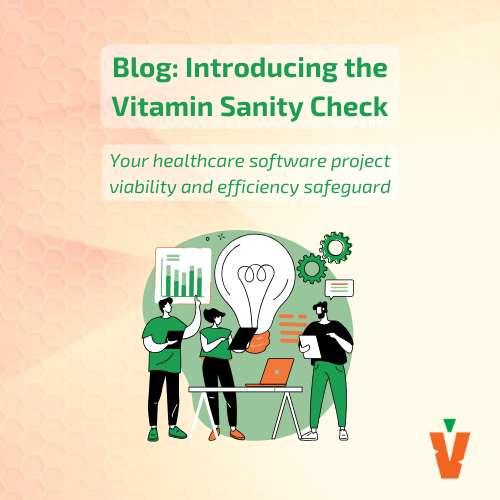Do you know what's our weapon for selecting viable projects to improve patient outcomes and healthcare technology progress? The Vitamin Sanity Check.
Are you toying with a product idea? Most software companies can help you only through technical support, while staffing agencies throw people at the problem without considering the why behind the business idea. It’s different at Vitamin Software — we act as strategic partners for your company. Being honest about our capacities is at the core of our mission, vision, and values, and we’re always eager to optimize a project plan before executing it.
The Vitamin Sanity Check is the initial step of our development process, a filter to (dis)qualify requests based on viability and capital efficiency. It ensures every project we accept is a partnership that makes ourselves and our clients more successful. For decision-makers in healthcare software, it’s a guarantee that we’ll get things done and get them right.
Do you have a software idea or feature and feel uncertain whether it’s feasible and worth the resources? Learn about the Vitamin Sanity Check to find your answer.
What Is the Vitamin Sanity Check?
Honesty is at the core of the Vitamin Software philosophy. We’re not ones to accept projects and figure them out as we go — confidence in our capacities lets us be reliable and fulfill our promises. Sanity-checking client requests is the way to do that.
The Vitamin Sanity Check is the process of discerning whether a project is viable and capital-efficient at the very start. It helps us assure quality, optimize resources, and achieve long-term success.
If a request doesn’t meet this criterion, we suggest options to improve it before getting our hands on development.
What Does the Vitamin Sanity Check Determine?
The Vitamin Sanity Check involves analyzing the following:
- Client demands. We thoroughly assess your requirements, gaining an understanding of your business needs and pain points.
- Viability. We analyze the feasibility of each project, considering technical, financial, and operational aspects to ensure it aligns with our capabilities and industry standards.
- The product-market fit matrix. The Sanity Check determines if we’re your best option for fixing a specific problem or addressing a business growth opportunity. That’s how we build long-term partnerships and avoid one-off transactions.
- Capital efficiency. We guarantee a prudent use of your funds. As part of our discovery phase, we recommend project scopes with the maximum return on investment and (sometimes) even a leaner budget.
- The risk strategy. We identify potential risks early on, allowing us to set realistic timelines and expectations. All healthcare projects carry a fair amount of tech, logistics, and legal risks, but having done over 60 successful product launches - we know how to mitigate them as early as in the planning stage.
Vitamin Sanity Check Step-By-Step
The Vitamin Sanity Check is a five-step process. It starts when a client expresses a need and consists of consultation calls and internal discussions.
Step 1: The BANT Questionnaire
The BANT questionnaire saves a huge amount of time by letting us disqualify unsuitable requests. For example, Vitamin specializes in healthcare SaaS products for administrative tasks — data transmission and storage, prescriptions, scheduling, reporting, or transactions. If contacted by a client seeking software for a medical device, we’ll refer them elsewhere.
If the project doesn’t immediately get disqualified, we learn the available budget, expected timeframe, the proposed solution, and who has the authority to sign off on it.
Step 2: Drafting the SRS
Upon getting basic information, we put our engineering hats on and devise a software requirements specification (SRS) document. Our Business Analyst determines what the healthcare SaaS solution is supposed to do and which features it should contain to solve the client’s needs.
We define the internal and external dependencies, use cases, and user stories. We also consult as needed, suggesting the most efficient and cost-effective development approach.
Step 3: Ballparking
Since we’re a software development partner, our Business Analyst and solution architect from the engineering team join forces to approximate the cost and timeline for your healthcare SaaS project. The proposed budget and timelines are engineering estimations. We also determine the blockers — the dependencies the client should provide so we can build their solution.
Of course, collaboration with other platforms enters into the cost and timeline estimates to guarantee accuracy. For example, while creating a data pipeline for Nithio, we had to integrate the solution with the Databricks PaaS, so we planned for that from the initial planning stage.
With estimates gathered, a dedicated Project Manager analyzes the proposal and confirms that it responds to the need our client expressed.
Step 4: Drafting the SoW
The next step is to create an SoW for software project development by referencing the SRS and ballparks. This document makes the partnership official and greenlights the roadmap.
We devise a document that outlines the scope, objectives, deliverables, timelines, and other essential details. It also defines what obligations we’ll assume, the communication channels, the reporting structure, and the success metrics. In some cases, the client steps in to assist with the last point of the SoW.
Step 5: Go/No-Go Decision
The final step of the Vitamin Sanity Check is to take everything back to the client. We discuss the timeline and budget, which may differ from the initial idea, and the technologies we’ll use. We explain our reasoning for the changes we introduced to the client’s original request.
In more complex cases, this is also the stage of revising the SRS by drilling into the client’s original request and any assumptions about the scope. That’s how we discover if we failed to surface any functionality and avoid scope creep.
The process ends with the client deciding which option to go with. After we agree on specific delivery terms, including milestones and deadlines, we launch the healthcare SaaS solution design stage.
How the Vitamin Sanity Check Ensured a Timely Launch and Saved $500,000+
The Vitamin Sanity Check is the first step of every project we launch, and sometimes, the results are dramatic. We want to touch on one case study that demonstrates its impact — read the full version here if you’re interested in additional details.
A client working on a patient-pharmacists app approached us with a large demand: 100 user stories on a limited time and budget. Instead of refusing outright or accepting and doing a shoddy job, we narrowed the scope to the 20 most important stories for the launch date. This saved them around $500,000 in creating these stories and prevented the additional monetary blow they’d suffer for failing to meet the release date. We’re now developing the remaining stories on a much looser timeline.
Vitamin Sanity Check: Key Takeaways
It’s our mission to be the most reliable healthcare software development company on the market, and the Sanity Check ensures just that. You can adapt these principles or work with us, assured that we’ll take excellent care of your company, resources, and objectives.
Are you seeking a software development partner or looking to test the viability of your next project? Schedule a consultation and let’s chat.
Frequently Asked Questions
What is involved in the Vitamin Sanity Check?
The Vitamin Sanity Check consists of three decisions: the budget, timeline, and features. Then it’s back to the meeting to decide whether the project is a go or a no-go.
How many projects can we Sanity Check at a time?
We usually perform the Vitamin Sanity Check on one project or SoW at a time. If working with an existing client in a longer-term engagement, we might scope a new project as the previous one enters the implementation phase to keep things efficient.
How does a project fail the Sanity Check?
A project can fail the Vitamin Sanity Check if the client provides unclear information and underdeveloped user story requests. We need this information to create a cost ballpark and tentative timeline. We can’t estimate viability, capital efficiency, or approach without clear input.
But don’t worry — we have plenty of experience communicating what we need you to provide and tailoring our language to executives, Project Managers, and engineers. One meeting in, you’re fully equipped to do your part in the Sanity Check after a meeting.
Do we suggest what the client should keep or remove?
While the client decides how their product looks, we usually offer opinions about features, UI, UX, and underlying technologies. We seek to simplify when requests are over-complex and suggest best practices, consulting the client toward success.
Does the client always decide the timeline?
The client has the final word regarding the project timeline, but they can’t ask for the impossible. Instead, we seek the best compromise between what they need and what’s possible, given their requirements and the resources allocated to develop a high-quality, long-lasting product.
Clients tell us their desired timeline and whether they have hard deadlines like customer demos to prepare for. Based on this information, we create a proposed timeline and negotiate it with them, sometimes with the help of our CEO. If there are immediate milestones preceding the final deadline, we discuss them directly with the Product Team.
Who has the final word on the go/no-go?
The client decides whether they’ll continue working with the specific project after the Vitamin Sanity Check. However, the final proposal is on our terms, as we analyze their request and determine what is needed to make it happen.




.png)